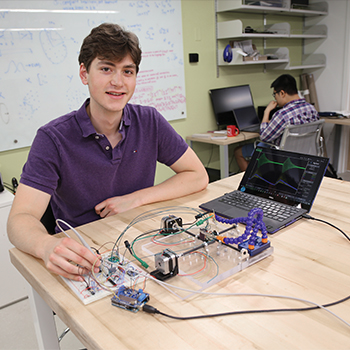Caleb Tulloss ’18 Looks to Develop Implantable Eye-Tracking System
In the rapidly growing intersection between electronics engineering and neuroscience, Caleb Tulloss ’18 seems to have found his place. The electrical engineering concentrator from Weston, Mass. is working to develop a fully-implanted solution to eye-tracking.
 His work has begun with external benchtop electronics, and by the end of the summer, he will have outlined a plan toward fully implanted implementation. Such a system would enable constant tracking of gaze and focus in neuroscience experiments, gaining a greater technological ability to study attentional relationships to brain activity, but also basic processing of the visual system.
His work has begun with external benchtop electronics, and by the end of the summer, he will have outlined a plan toward fully implanted implementation. Such a system would enable constant tracking of gaze and focus in neuroscience experiments, gaining a greater technological ability to study attentional relationships to brain activity, but also basic processing of the visual system.
His proof-of-concept prototype apparatus was first envisioned by Assistant Professor David Borton, and Ph.D. student Marc Powell. Powell was working on his BrainCell project, linking several stages of wireless communication together to record from many different areas of the cortex at the same time. Occupied with this project, he needed an undergraduate to investigate an implantable eye tracking system. Meanwhile Tulloss, who had completed an Intro to Neuroscience class and was enjoying his forays into circuit design, still had the thought of neuroengineering in the back of his mind. He stumbled upon the opening in the Brown Neuromotion Lab at the right moment.
“They were looking for a device to be used by neuroscientists in experiments. We talked about coils embedded in the eye socket, to detect the orientation of the eye, which would involve similar circuitry to what I had been working on,” Tulloss said.
The goal of Borton’s lab is to design, develop and deploy neurotechnology to better understand the nervous system. By monitoring the nervous system of nonhuman primates as they move freely within their environment, scientists learn about the complex dynamics of neural circuits during movement in a naturalistic setting. Eye tracking is an important part of such studies, providing information about how an animal navigates its surroundings, interacts with objects, and avoids obstacles. Current solutions to the challenge of eye tracking require the subject to be head-fixed, and are therefore of limited use in a freely moving paradigm. Tulloss’ prototype could solve that for researchers going forward.
Professor Borton has certainly designed a lot of circuits, which is my passion as well. He’s a biomedical engineer who is not afraid of the electronic side of things.
“Professor Borton has certainly designed a lot of circuits, which is my passion as well,” Tulloss said. “He’s a biomedical engineer who is not afraid of the electronic side of things. Although we’re coming from the two different backgrounds, he’s a great role model for me – finding the interface between humans and technology. He’s been a very patient and supportive mentor.”
In January, Tulloss spent two and a half weeks working on a MATLAB algorithm for the orientation of the eye, and the spring semester was spent testing the circuit design on the benchtop model. Recently he and Powell have discussed changing the coil geometry, using simulations to validate their new approach. Thus far, the work has been purely electrical, not yet involving any tissues. He is also aided by the fact that he recently completed Borton’s Implantable Devices course, a class that introduces design methods and challenges unique to creating an implantable device.
Over the summer, he plans to finalize the circuitry and software, and then determine the best way to implant an animal model. Tulloss will be greatly assisted in this venture by the Neal B. Mitchell ’58 Systems Thinking Project Award which provides monetary support for an undergraduate student, in a summer or semester of collaborative research with an individual faculty member, for research and study associated with systems thinking or an advanced building structure.
“I really like that the idea of the Mitchell award is to be used for project funds, not just a summer stipend,” Tulloss said. “I feel like it is teaching me how to manage grants in a way.” Asked about his plans after graduation, he said, “I’m going to be looking at Ph.D. programs, in either electrical or biomedical engineering. I’d really like to explore feedback and closed-loop control for the nervous system.”